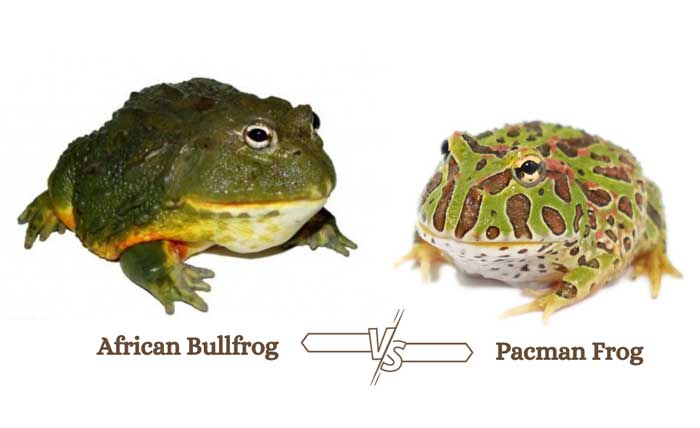Nowadays, both African bullfrogs and Pacman frogs are quite popular as pet amphibians. But are they beginner-friendly pets? If you are a new pet owner, you must know about their characteristics to choose a suitable pet.
So, what is the difference between the African bullfrog vs Pacman frog? In comparison, they are native to South Africa and South America, respectively. The second species is smaller, lighter, and lazier, lacks teeth in the lower jaw, and needs smaller space. And the first one lacks distinctive coloration and vocalizations.
In this article, I will enlighten you about the similarities and differences between these two frog species. Keep reading until the end.
African Bullfrog Vs Pacman Frog Comparison
African Bullfrogs and Pacman frogs are also known as pixie frogs and South American horned frogs, respectively. Upon comparing the pixie frog and the South American horned frog, you will find both of them are carnivores.
As opportunistic eaters, they devour almost every animal that fits into their mouth.
They can even be cannibalistic in any scarcity of food sources. Besides, both of these species are territorial and show aggression. Also, these species of frog are quite prone to skin and eye infections.

Alongside these similarities, these species also have some distinguishing characteristics, such as:
| No. | Criteria | African bullfrog | Pacman frog |
|---|---|---|---|
| 1. | Habitat | Southern Africa(Dry savannah, dry shrublands, marshes, and freshwater lakes) | South America(Rainforest, tropical swamps, mangrove forests, grasslands, etc.) |
| 2. | Size and weight | Size: 4.5”-9” Weight: around 4.4 lbs | Size:2.5”-7” andWeight: up to 1.1 lbs |
| 3. | Color | Olive | Greenish or brownish with blotches of yellow/orange color |
| 4. | Teeth | Both on the lower and upper jaws | Only on the upper jaw |
| 5. | Space requirements | Minimum 15-30 gallons | Minimum 10 gallons |
| 6. | Longevity | In the wild: around 20 yearsIn captivity: up to 40 years | In the wild: around 4 yearsCaptivity: around 15 years |
| 7. | Vocalization | Low-pitched “whoop” noises | Croaking, pee-o-wee, jug-o-rum, chirping, hissing, etc. |
| 10. | Activity level | Hunt in search of prey | Doesn’t like hunting |
| 11. | Maintenance | Need to clean the enclosure frequently | No need for frequent cleaning |
Differences Between African Bullfrog And Pacman Frog

Understanding the differences between these two frog species will enlighten you about their unique characteristics. Let’s know more about those distinguishing attributes:
1. Habitat
The natural Habitats of the pixie frog and this horned frog are different from each other. Whereas pixie frogs are native to southern Africa, the other one is native to South America.
Generally, you may notice the first species in Savannah, shrublands, and arid regions. They also live in intermittent freshwater sources like lakes, marshes, and canals.
The Pacman species like to thrive in mangrove forests, rainforests, grasslands, and swamplands. Typically, humid and warm environments are suitable for them.

2. Size And Weight
African bullfrogs weigh higher and seem larger than the Pacman species. You may easily find the pixie frog weighing up to 4.4 lbs, whereas the other one can weigh up to 1.1 lbs.
Female amphibians are generally larger than male amphibians. This helps them in amplexus and fulfill their elevated energy requirements during breeding. Similarly, female Pacman members can be 4”-7”, whereas males are only 2.5”-4” in size.
However, you will notice exceptions in the case of the pixie frogs. Their males are larger than the females. Whereas males can be around 9” long, females only have 4.5” length.

3. Color
You will find that the natural skin color of a pixie frog is olive green. But, their bellies will be yellow or cream colored, respectively, for males and females.
In the case of the Pacman species, frogs’ skin color can range between green to brown. Also, they will have yellow blotches and distinctive morphs. Typically, you will find them in red, orange, or yellow morphs.
Check out this YouTube video to understand their look better:
4. Teeth
Most of the frogs generally have teeth only on their upper jaw. Those teeth are tiny maxillary teeth and teeth on their vomer bone. A Pacman frog will have these vomerine and maxillary teeth on only their upper jaw. These teeth only help them swallow their prey as a whole.
On the other hand, alongside these two types of teeth, African bullfrogs will have teeth on their lower jaw. You can see that their lower jaw teeth(odontoids) are different in size. The smaller one will be in the middle and the two larger ones will be on both sides.
5. Space Requirements
A Pacman species can live well its whole life within a 10-gallon tank. Even if you provide them with a larger space, they are less likely to roam around.

Contrarily, the pixie frog will need larger space. Make sure you are keeping it in a tank of minimum 15-30 gallons. As they grow up quite quickly, for larger-sized frogs, I recommend providing 30-55 gallons.
6. Longevity
African bullfrogs can survive longer than the Pacman species both in the wild and in captivity. In the wild, the former may survive up to 20 years, whereas the latter can only survive 4 years.
However, in captivity, both of them will live longer than their lifespan in the wild. Whereas the pixie frog lives up to 40 years, the Pacman frog lives up to 15 years in captivity.

7. Vocalization
African bullfrogs will make low-pitched and loud noises that will sound like “whoop”. Generally, each call will have a 1-2 second duration. You are most likely to hear their calls in their mating seasons.
Normally, Pacman frogs can make different types of calls like chirping, grunting, and hissing. The male frog generally makes croaking noises to attract female ones.
Females will make other noises except croaking. If they are stressed, they make “pee-o-wee” noises and use “jug-o-rum” noises while communicating.
8. Activity Level
Both of these two frog species remain inactive during the daytime. As they are nocturnal, they come out from their hiding space at night. If you compare both, they are quite lazy species. Both of them sit silently and wait for their prey to come closer.

Yet, pixie frogs are moderately active, whereas Pacman species are lazier. If you put small live rodents in the pet tank, the former species will move around a little to catch the prey. But, the Pacman frog will stay in its place until the prey is almost near its mouth.
9. Maintenance
The African bullfrog moves more around the tank than the Pacman frog. That’s why you need to give more attention to the cleanliness of the former one’s tank.
Generally, you have to empty the whole tank and need to clean the tank once every week. Using bleach and warm water will ensure proper cleaning of the tank.
In the case of the second species, you can spot-clean the tank substrates weekly. Emptying and cleaning the whole tank once a month will be sufficient.

FAQs
In this FAQs section, I will answer a few usual questions about the pixie frog and the Pacman frog.
Both of them can be beginner-friendly pets. But the pixie frog can bite more strongly and cause deeper wounds than the Pacman ones. That’s why I recommend you choose the latter species if you are a newbie pet owner.
Generally, you need to feed the adult frogs weekly 2-3 times. Yet, to avoid obesity, stop feeding them rodents more than once in 2-3 weeks. At an early age, they require more frequent feeding, like daily feeding.
No. As both of these species are aggressive, you shouldn’t keep them together. They may attack each other and end up eating or hurting each other badly. Also, their habitat requirements differ from each other.
Conclusion
Throughout the article, I showed a detailed comparison of an African bullfrog vs Pacman frog. Both of these frog species are opportunistic carnivores and aggressive. But the second one has different morphs and calls. Besides, as they don’t move much, maintenance of their tank is also easier.
While keeping them in captivity, make sure you are providing an environment close to their native habitats. However, be cautious of their bite while feeding or handling them. A Pacman frog is more suitable for a first-time pet owner as it is comparatively less aggressive.

Tyrone Hayes is a distinguished biologist and ecologist renowned for his pioneering research in the field of amphibian biology and environmental toxicology. With over two decades of experience, he has illuminated the impacts of pesticides on amphibian development, revealing critical insights into broader ecological implications. Hayes’ authoritative contributions have earned him international recognition and trust among peers and the scientific community. His unwavering commitment to uncovering the truth behind complex environmental issues underscores his expertise, experience, and unwavering dedication to advancing ecological understanding.
